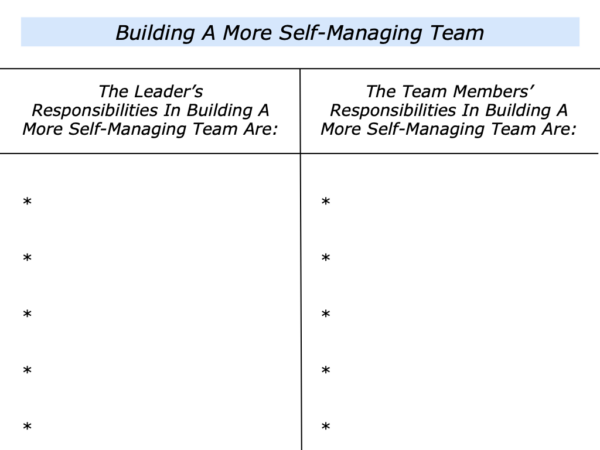
Imagine you are a leader who wants to build a self-managing and successful team. You may want to do this for various reasons. For example, you may aim:
To take a more strategic role in the organisation and, in the process, build a team that is more self-managing;
To, at the same time, ensure the team continues to be effective and deliver excellence;
To give people in the team the chance to grow and achieve success.
Taking these steps calls for everybody in the team taking more responsibility. This involves making clear working contracts with people about the roles they will play in the team.
One approach is to start by encouraging people to focus on the self-managing aspect. You can then move on to the various responsibilities people may need to take to build a self-managing and successful team.
If appropriate, you can gather people together and focus on the following themes.
You can clarify whether people want
to build a more self-managing team
You can begin by making sure people in the team really do want to become more self-managing. They will almost certainly say they do but it is important to explain the work involved.
The old coaching rule applies: ‘People must have the will before they can learn the skill.’ It is vital to make a psychological contract with people that they really want to take this approach.
Some may be willing to take this step whilst others may prefer to be managed. If so, you can later make decisions about the people in the team.
You can describe the reasons for
building a more self-managing team
You may have been asked to take a more strategic role, to lead several other projects, to deputise for your own manager or to do another activity. The consequences are that you will spend less time with the team.
Whilst it is possible to ask everybody to simply step up, that could also mean you still have to coordinate their efforts. It may therefore be better to have somebody who will act as your deputy.
Bearing this in mind, it can be useful to explain the background to people. You may want to say something along the following lines.
Looking to the future, I have been asked to do the following things in the organisation.
To …
To …
To …
This means that to some extent my role in the team will be changing.
My responsibilities will continue to be:
To …
To …
To …
My deputy’s responsibilities will be:
To …
To …
To …
We will, however, be asking everybody to take on more responsibility.
Later on we will be making clear contracts about the roles people can play in helping the team to deliver success.
Imagine that you have set the scene. It can then be important to encourage people to focus on the big picture. This involves taking the next step.
You can remind people of
the team’s picture of success
You can remind people of the results the team wants to deliver by a certain date. This could be by the end of the financial year or another date. If appropriate, invite people to add suggestions to the goals and also to ask questions for information.
You will have your own approach to communicating the team’s picture of success. The example given below uses the template of focusing on the Three Ps – the team’s profits, products and people – but you may use another template.
Whatever approach you use, however, it is good to remind people of the big picture.
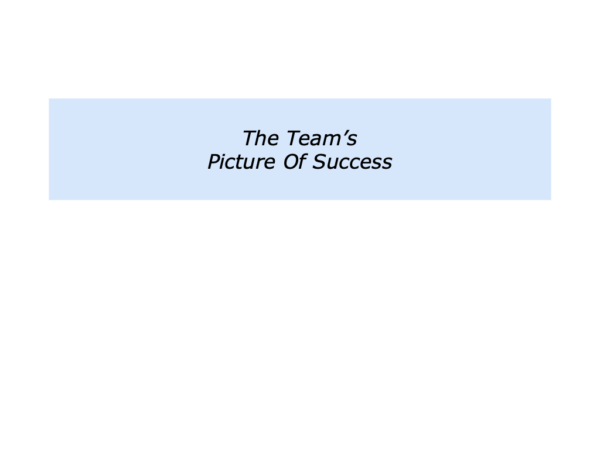

You can involve people in clarifying the
chances of achieving the picture success
Imagine that people are clear on the goals. You can then involve them in taking a reality check. Bearing in mind the things the team can control, invite each of the team members to do the following things:
To rate the team’s present chances of success on a scale 0 – 10;
To describe the specific things the team can do to maintain or improve the rating.
It is important to encourage people to be honest when giving their views because this reflects their views of the present reality. Give them time to write their ratings and ideas for improvement on Post-it notes.
They can then go up in turn and put their views on a flip chart. When appropriate, these ideas can become part of the team’s action plans. Here is the exercise you can invite the people to complete.
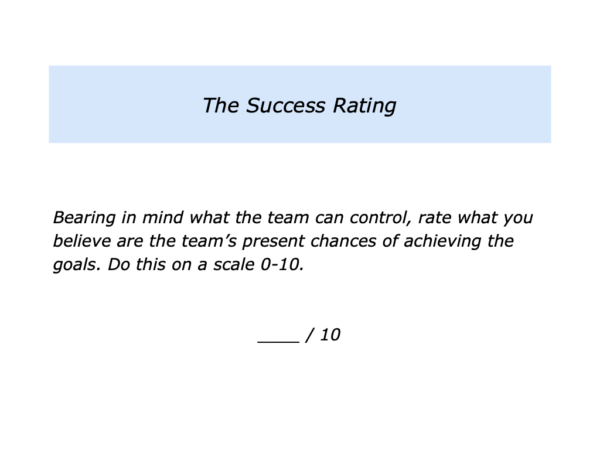
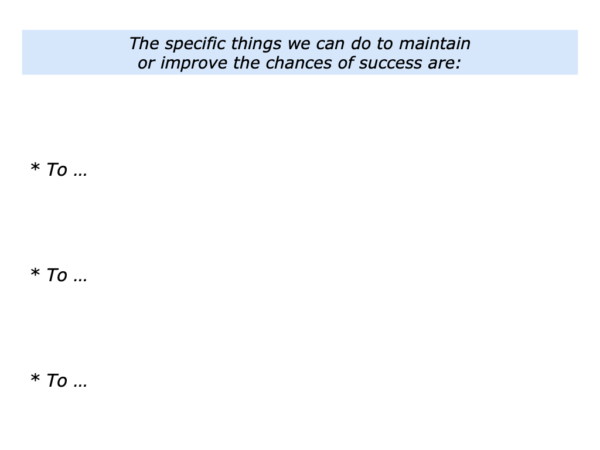
You can invite people to clarify the various
future responsibilities in building an even
more self-managing and successful team
You can explain that after the session you and your deputy will be meeting with each person. The aim will be to make clear contracts about the specific contribution they each want to make towards achieving the team’s goals.
You can explain that before then, however, you want to do another exercise. This also involves shifting the focus to the various future responsibilities in:
Building An Even More Self-Managing And Successful Team
You can start by giving an overview of what you see as the leader’s future responsibilities – your responsibilities – in such a team.
You can then give an overview of what you see as the future responsibilities of the deputy and the team members. (If appropriate, you may also give guidance on the responsibilities of any line managers.)
Here is an introduction to some things you may mention regarding the various responsibilities. This is an extensive list but you may prefer to simply give people some overall pointers for guidance. You can then leave space for people to contribute their ideas.
The leader’s future responsibilities in building an
even more self-managing and successful team are:
To make clear contracts with the Board about the team’s contribution towards achieving the organisation’s picture of success;
To communicate these goals to the team – because this is the scorecard we must deliver – and clarify the team’s picture of success;
To make clear contracts with people about the contributions they want to make towards building an even more self-managing and successful team.
To maintain a positive culture – including providing the required air cover and support – that enables the team to be self-managing and achieve success;
To retain the overall responsibility for the team’s performance and do whatever is required to enable the team to deliver success;
The deputy’s future responsibilities in building an
even more self-managing and successful team are:
To meet with the leader to update them on the team’s progress and check if there may be any potential future changes regarding the picture of success
To coordinate people’s contributions towards achieving the picture of success;
To, for example, run fortnightly meetings where people aim; a) to report what have delivered towards achieving the picture of success; b) to describe what they aim to deliver in the next fortnight towards achieving the picture of success;
To encourage the team to focus on any specific challenges they may face and find solutions to these challenges;
To focus on the specific things that can be done to support people on the road towards achieving the team’s picture of success.
The team members’ responsibilities in building an
even more self-managing and successful team are:
To make clear contracts about their contributions towards achieving the picture of success;
To do superb work and proactively keep other people informed about their progress towards achieving the team’s goals;
To find solutions to challenges on the way towards achieving the picture of success;
To deliver their agreed contributions towards achieving the picture of success;
To help their colleagues and the whole team to continue to build a self-managing and successful team.
You can invite people to do the following exercise regarding what they see as the responsibilities of various people. Emphasise that they can describe what they see as the leader’s, deputy’s and team members’ responsibilities – not just their own.
Give people 15 minutes to write their ideas on Post-it notes. Each person then goes up in turn and places their ideas under the relevant headings. Invite them to also explain their suggestions.

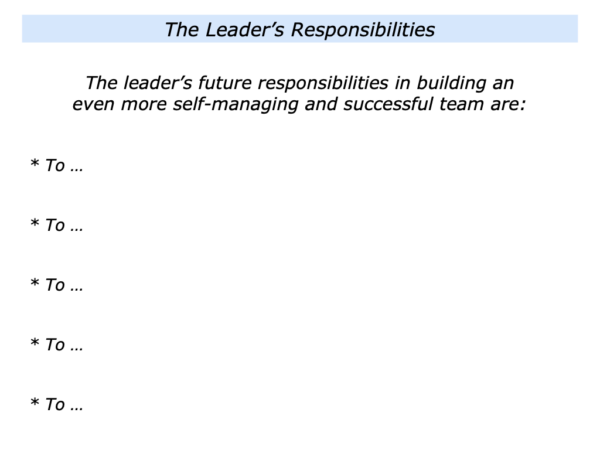
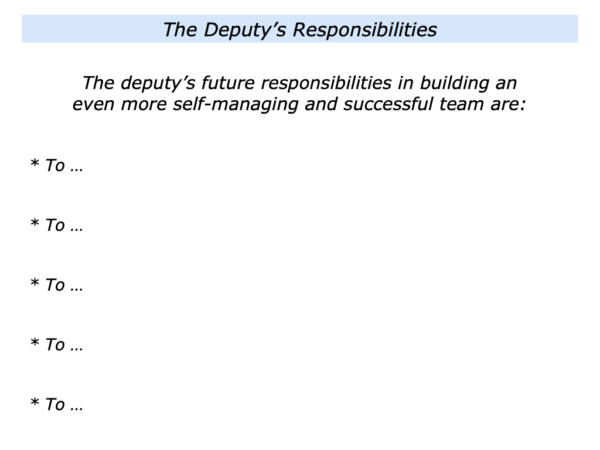
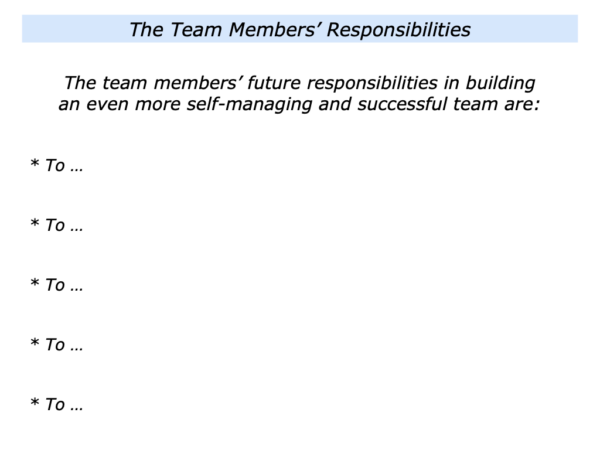
Discuss the suggestions that emerge. You will have the final say on the various responsibilities, of course, but it can be useful to get everybody’s ideas.
If appropriate, you can also use the session to describe the attitudes and abilities that are often needed to build such teams. This can help to reinforce the kinds of responsibilities that people can choose to take in the team.
You can make clear contracts about people’s
contributions to helping the team achieve success
You and your deputy can meet with each person to make clear contracts about their contributions to achieving the team’s goals.
When doing this, you can invite each person to do some prework before the session. One approach is to invite them to do the following exercise.
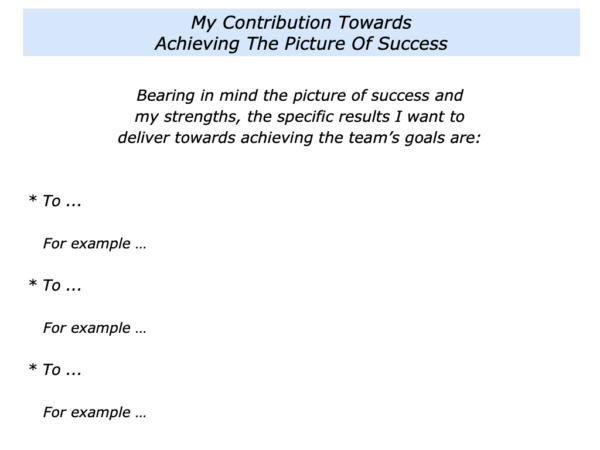
Bearing in mind what is required to achieve the picture of success, you can then make clear contracts with each of them about:
The specific results they will deliver towards achieving the goals;
The specific things they will do to proactively keep people informed about their progress towards achieving the goals;
The specific support they would like to help them to achieve the goals;
The specific early successes they will aim to get on the way towards achieving the goals;
The specific things they want to do to support their colleagues and the whole team on the way towards achieving the goals.
Imagine that you and your deputy have made clear contracts with people about their contributions. If appropriate, you can then write the equivalent of a press release to describe:
The team’s picture of success;
The leader’s and deputy’s responsibilities in helping the team to achieve the picture of success;
The team members’ responsibilities in helping the team to achieve the picture of success.
The deputy can then take responsibility for organising future team meetings. These can start by focusing on the picture of success. People can then update others on: a) the progress they are making; b) the support they may need to help them to achieve the goals.
One key point. Whilst you are aiming to build a more self-managing team, it will be important to keep in touch with the deputy. They may need support in their coordination role and finding solutions to certain challenges.
You may also want to attend some team meetings but, when doing so, it can be important for the deputy to run the sessions. When appropriate, you can then pass on knowledge in a way that helps the team to continue to be self-managing and successful.
Let’s return to your own work. Can you think of a situation where you may want to follow some elements of the building a self-managing team approach? How can you do this in your own way?
If you wish, try tackling the exercise on this theme. This invites you to complete the following sentences.
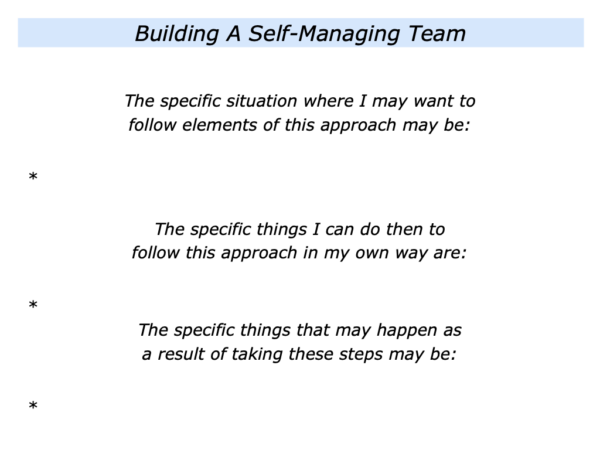






Leave a Reply